
Myeong-dong Station is a station on the Seoul Subway Line 4. This station is located in Jung-gu, Seoul.

Seoul National University Station is a station on Seoul Subway Line 2, located in Bongcheon-dong, Gwanak-gu of southern Seoul. This station is also known as Gwanak-gu Office Station. There are eight exits, two at each corner of the crossroads – of Nambu Beltway (Nambusunhwan-ro) and Gwanak-ro – where the station lies beneath.
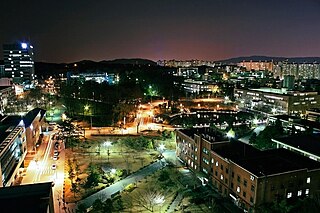
Nowon District (Nowon-gu) is a residential district of Seoul, South Korea, located in the most northeastern part of the metropolitan city. It has the highest population density in Seoul, with 619,509 people living in the area of 35.44 km².
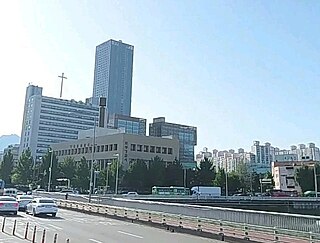
Dobong District is one of the 25 districts of Seoul, South Korea. As of 2020, Dobong has a population of 315,979 and an area of 20.71 square kilometres (8.00 sq mi), and is divided into four administrative neighborhoods. The district is located in northeastern Seoul, bordering the Gyeonggi Province cities of Yangju and Uijeongbu to the north, and the districts of Gangbuk to the southwest and Nowon to the east.

Kkachisan Station (pronunciation as Katsisam) is a station on Seoul Subway Line 5, as well as the northwestern terminus of the Sinjeong Branch of Line 2. Seoul Metro operates both Line 2 and 5 platforms.
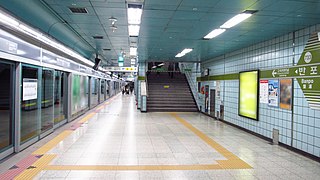
Banpo Station is a metro station on Seoul Subway Line 7 located in Jamwon-dong, Seocho District, Seoul. Despite its name, the station is not located in Banpo-dong, but instead in Jamwon. It has 6 entrances that they are all right side entrance and they have screen doors right before entering the train. It takes 4~8 minutes between 2 trains and next stations are Nonhyeon and Seoul Express Bus Terminal. It is only 500m long between Banpo station and two other Stations next to it. The station number is 733.

Sindang Station is a subway station on the Seoul Subway Line 2 and Line 6.

Seongsu Station is a rapid transit station on Seoul Subway Line 2. It is located in Seongsu-dong in the Seongdong-gu administrative district of Seoul. It is also the southeastern terminus of Line 2's Seongsu Branch to Sinseol-dong. Trains needing to be serviced take the Seongsu Branch from this station and go to the Gunja Train Depot behind Yongdap Station.

Dobong Station is a metro station on Seoul Subway Line 1. It is in the extreme north of Seoul and offers services connecting the city to the cities to the north in Gyeonggi Province.

Banghak station is a subway station on Line 1 of the Seoul Metropolitan Subway. It is the closest station to the Dobong District Office in Seoul.
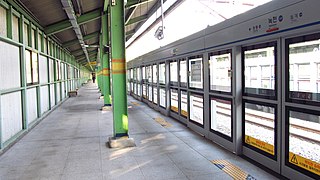
Nokcheon station (Korean: 녹천역) is a metro station on Seoul Subway Line 1 in South Korea. It is located in the northern end of the city.

Balsan Station is a station on the Seoul Subway Line 5 in Gangseo-gu, Seoul.

Gil-dong Station is a subway station on Seoul Subway Line 5 in Gangdong-gu, Seoul. There is a connecting track from this station to Dunchon-dong Station on the Macheonji Line of Line 5, but it is a return train track for the arrival and departure of the Godeok Vehicle Business Office and has nothing to do with passenger operations.
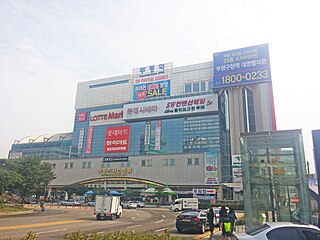
Bupyeong station is a subway station located in Bupyeong District, Incheon, South Korea. This station is on the Seoul Subway Line 1 and Incheon Subway Line 1. It is one of the busiest stations on the Incheon line because of its central location and its connection to the Seoul line.

Sangil-dong station is the subway station of Line 5 in Gangdong-gu, Seoul. Seoul Metro have extended the subway line from this station to Hanam Geomdansan in the nearby city of Hanam.

Mapo-gu Office Station is a Seoul Metropolitan Subway station near the Mapo district office in Seoul, opened in December 2000.

Samseong-Dong is an affluent neighborhood or ward of Gangnam-gu in Seoul, South Korea.

Gubeundari Station is a subway station on Seoul Subway Line 5 in Gangdong-gu, Seoul.

Suji-gu (Korean: 수지구), or Suji, is one of the three city districts in Yongin City, South Korea which is approximately 29 km south of Seoul. Suji became a city district on October 31, 2005, about nine years after Yongin officially became a city. When Yongin City was established in 1996, both urban and rural areas were covered to become a part of the city; thus to this day, Yongin's urbanization is varied throughout different regions of the city. Suji is one of the most urbanized areas of Yongin, as it borders Seongnam City's Bundang District and Suwon City, two more well developed areas. Home to the newly built Shinsegae Department Store and Dankook University in one of its towns, Jukjeon, Suji is rapidly developing as Yongin City becomes more and more urbanized. In recent years, the district has attracted upper-class Koreans, with the completion of the Samsung East Palace in 2010.
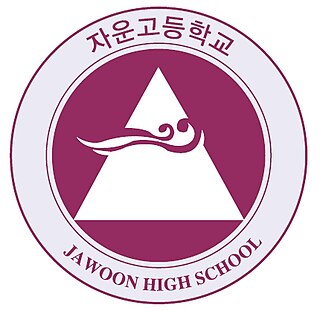
Jawoon High School, established in 2004, is a public high school located in Chang 4-Dong, Dobong-gu, Seoul. Jawoon High School is one of the newest schools with up-to-date facility in Dobong-gu, and it is well known as a Dobong-Vision School with Sunduck High School.

























